

Homo. Homo is the genus of hominids that includes modern humans and species closely related to them.
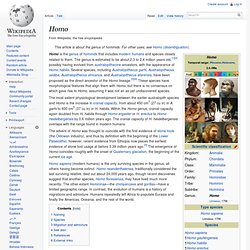
The genus is estimated to be about 2.3 to 2.4 million years old,[1][2] possibly having evolved from australopithecine ancestors, with the appearance of Homo habilis. Several species, including Australopithecus garhi, Australopithecus sediba, Australopithecus africanus, and Australopithecus afarensis, have been proposed as the direct ancestor of the Homo lineage.[3][4] These species have morphological features that align them with Homo, but there is no consensus on which gave rise to Homo, assuming it was not an as-yet undiscovered species.
The most salient physiological development between the earlier australopith species and Homo is the increase in cranial capacity, from about 450 cm3 (27 cu in) in A. garhi to 600 cm3 (37 cu in) in H. habilis. Homo sapiens (modern humans) is the only surviving species in the genus, all others having become extinct. Tree of life (biology) Hillis plot Tree Of Life, based on completely sequenced genomes.
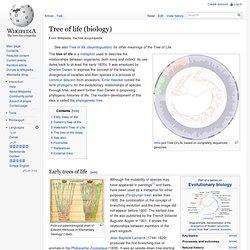
The tree of life is a metaphor used to describe the relationships between organisms, both living and extinct. Its use dates back to at least the early 1800s. It was employed by Charles Darwin to express the concept of the branching divergence of varieties and then species in a process of common descent from ancestors. Ernst Haeckel coined the term phylogeny for the evolutionary relationships of species through time, and went further than Darwin in proposing phylogenic histories of life. Evolutionary history of life. Timeline of evolutionary history of life. Phylogenetic tree. In a rooted phylogenetic tree, each node with descendants represents the inferred most recent common ancestor of the descendants, and the edge lengths in some trees may be interpreted as time estimates.
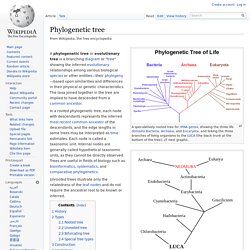
Each node is called a taxonomic unit. Internal nodes are generally called hypothetical taxonomic units, as they cannot be directly observed. Trees are useful in fields of biology such as bioinformatics, systematics, and comparative phylogenetics. Unrooted trees illustrate only the relatedness of the leaf nodes and do not require the ancestral root to be known or inferred. Three-domain system. Classification[edit] The three-domain system adds a level of classification (the domains) "above" the kingdoms present in the previously used five-or-six-kingdom systems.

This classification system recognizes the fundamental divide between the two prokaryotic groups, insofar as archaea appear to be more closely related to eukaryotes than they are to other prokaryotic bacteria. The current system has the following listed kingdoms in the three domains: Domain Archaea – prokaryotic, no nuclear membrane, distinct biochemistry and RNA markers from bacteria, possess unique ancient evolutionary history for which they are considered some of the oldest species of organisms on Earth; traditionally classified as archaebacteria; often characterized by living in extreme environments. Some examples of archaeal organisms are methanogens with produce the gas methane, halophiles which live in very salty water, and thermoacidophiles which thrive in acidic high temperature water. Kingdom (biology) Prefixes can be added so subkingdom and infrakingdom are the two ranks immediately below kingdom.
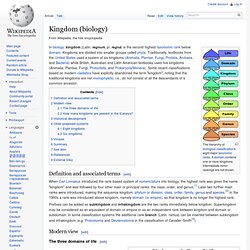
Superkingdom may be considered as an equivalent of domain or empire or as an independent rank between kingdom and domain or subdomain. In some classification systems the additional rank branch (Latin: ramus) can be inserted between subkingdom and infrakingdom (e.g. Protostomia and Deuterostomia in the classification of Cavalier-Smith[3]). From around the mid-1970s onwards, there was an increasing emphasis on comparisons of genes on the molecular level (initially ribosomal RNA genes) as the primary factor in classification; genetic similarity was stressed over outward appearances and behavior.
Taxonomic ranks, including kingdoms, were to be groups of organisms with a common ancestor, whether monophyletic (all descendants of a common ancestor) or paraphyletic (only some descendants of a common ancestor). One hypothesis of eukaryotic relationships, modified from Simpson and Roger (2004). Phylum. General description and familiar examples[edit] The definitions of zoological phyla have changed importantly[clarification needed] from their origins in the six Linnaean classes and the four "embranchements" of Georges Cuvier.[3] Haeckel introduced the term phylum, based on the Greek word phylon.
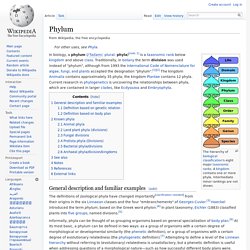
In plant taxonomy, Eichler (1883) classified plants into five groups, named divisions.[5] Definition based on genetic relation[edit] This changeability of phyla has led some biologists to call for the concept of a phylum to be abandoned in favour of cladistics, a method in which groups are placed on a "family tree" without any formal ranking of group size.[7] Definition based on body plan[edit] A definition of a phylum based on body plan has been proposed by paleontologists Graham Budd and Sören Jensen (as Haeckel had done a century earlier). This approach brings some small problems—for instance, ancestral characters common to most members of a phylum may have been lost by some members.
Notes[edit]